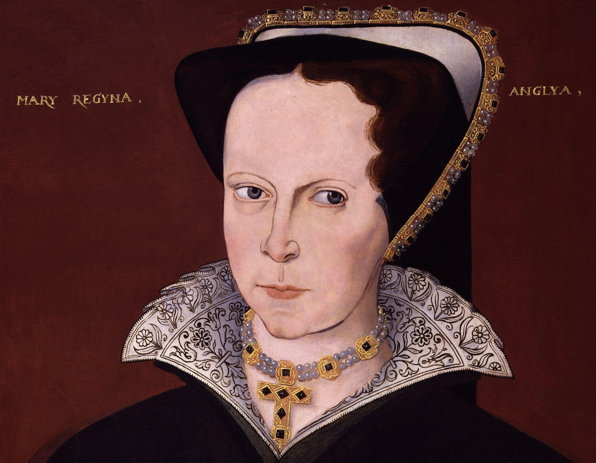Mary I of legend – cold, brutal, unforgiving
History is written by the victors. In Mary Tudor’s case, her reign was written by her protestant enemies during the tenure of her half-sister, Elizabeth. Foxe’s Book of Martyrs, by John Foxe, tells a tale of grinding religious tyranny with Mary running rough-shot across the fair and peaceful land of England, dragging the population back to the Church of Rome and burning those who would not submit to her will. This tale has survived throughout history, earning Mary the title ‘bloody’. In fact the population Mary I was ruling could be defined more as Catholic than Protestant. The people of England during the 1550s were not the Cromwellian style Puritans that Foxe’s martyrs inspired. In fact Mary’s counter-reformation did not cause the widespread condemnation that has been popularly recorded. Mary enjoyed the majority support of her Bishops and the support of Parliament during the implementation of her religious policy.
Another prospective- Mary I as imagined by William Henry Egleton 1833-1862
Of course there were Protestant radicals who resisted and spoke openly about the evils of the Catholic Church but these were extremists, people who Mary’s father Henry VIII and her sister Elizabeth would have had no hesitation in burning. Mary did burn them and offer no reprieve, seeing them as dangerous heretics. But this was not an unusual punishment for religious heresy and the laws the punishments were based upon enjoyed the support of the political elite during Mary’s reign. One of the main reasons why the burnings are remembered was that they occurred so frequently in such a short amount of time; 300 burnings over a 3 month period. But to condemn Mary of this and allow the other Tudor monarchs to be remembered more favourably seems a little hypocritical. After all Mary’s father ordered the deaths of nearly 37, 000 people while Elizabeth had 600 people executed.
Mary at the beginning of her reign – popular and triumphant
Nor was Mary unusually harsh to those condemned of crimes of a non-religious nature. In fact on average Mary commuted capital punishments far more than Elizabeth, believing in the ideals of confession and redemption, she would often offer last minute reprieves of the death penalty if she felt that the accused was truly sorry for their transgressions. In this sense she was far more lenient to those who had wronged her, even towards the people that conspired to overthrow her in the two rebellions she had to deal with during her reign.
Princess Mary aged 28
Why than do we remember Mary’s reign as bloody? Indeed if body count of condemned subjects is taken into account, Mary’s reign could be seen as relatively bloodless. It is partly a question of religion, Mary was the last Catholic monarch not to be overthrown by Protestantism, in this sense she represents a retraction, a last ditch attempt to change a country that, forever after, based Protestantism and the freedom of the English Church as a cornerstone of English identity. English identity thus sees Mary’s reign as an unqualified failure since it was so overtly Catholic or un-English. It is also a question of who Mary loved and what she loved. In both cases it was not England but Spain. Unlike Elizabeth, Mary married and not only that, married the foreign prince Philip II of Spain, against the advice of a large faction of her government. Elizabeth didn’t marry anyone, against the advice of a large faction of her government but she remained English, through her religious views and her commitment to Protestantism. Mary didn’t remain English she became something else, something more Spanish and because of this her reign has always been remembered with a certain amount of notoriety.




